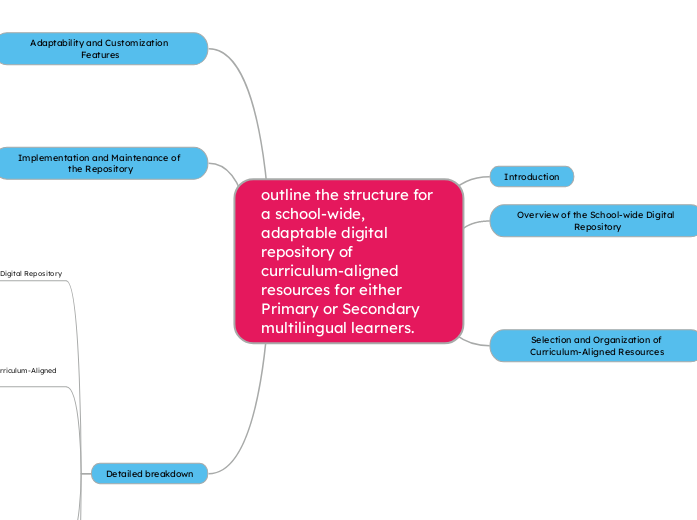outline the structure for a school-wide, adaptable digital repository of curriculum-aligned resources for either Primary or Secondary multilingual learners.
Introduction
Overview of the School-wide Digital Repository
Purpose and benefits of the repository
Target audience
Primary or Secondary multilingual learners
Selection and Organization of Curriculum-Aligned Resources
Identification of curriculum standards and objectives
Common Core Standards for Primary or Secondary education
Curation of resources based on curriculum alignment
Language-specific resources for multilingual learners
Multilingual resources for content areas (e.g
math
science)
Tagging and categorization of resources for easy navigation
Language tags (e.g
English
Spanish
French)
Subject tags (e.g
math
science
social studies)
Adaptability and Customization Features
Differentiation options for diverse learner needs
Leveled resources for different proficiency levels
Accommodations for students with special needs
Personalization options for individualized learning
Student profiles for tracking progress and preferences
Customizable learning pathways
Implementation and Maintenance of the Repository
Integration with existing learning management systems
Collaboration with teachers and subject matter experts for resource updates
Regular assessment and evaluation of resource effectiveness
Ongoing professional development for teachers on repository usage
Detailed breakdown
Overview of the School-wide Digital Repository
Purpose and benefits of the repository
Centralized storage and accessibility of curriculum-aligned resources
Facilitation of multilingual learning for Primary or Secondary students
Target audience: Primary or Secondary multilingual learners
Students who are learning multiple languages alongside their academic subjects
Selection and Organization of Curriculum-Aligned Resources
Identification of curriculum standards and objectives
Common Core Standards for Primary or Secondary education
Identify specific standards that need to be addressed
Curation of resources based on curriculum alignment
Language-specific resources for multilingual learners
Resources that focus on language acquisition and development
Multilingual resources for content areas (e.g., math, science)
Resources that cover academic subjects in multiple languages
Tagging and categorization of resources for easy navigation
Language tags (e.g., English, Spanish, French)
Tagging resources based on the language they are presented in
Subject tags (e.g., math, science, social studies)
Tagging resources based on the academic subject they belong to
Adaptability and Customization Features
Differentiation options for diverse learner needs
Leveled resources for different proficiency levels
Resources tailored for beginners
intermediate
and advanced learners
Accommodations for students with special needs
Resources with adaptations for students with disabilities or specific learning needs
Personalization options for individualized learning
Student profiles for tracking progress and preferences
Profiles that allow students to track their learning journey and save preferences
Customizable learning pathways
Ability for students to choose their own learning paths based on their needs and interests
Implementation and Maintenance of the Repository
Integration with existing learning management systems
Ensuring compatibility and seamless integration with the school's existing systems
Collaboration with teachers and subject matter experts for resource updates
Regular communication with teachers and experts to keep the repository up to date
Regular assessment and evaluation of resource effectiveness
Conducting evaluations to measure the impact and effectiveness of the resources
Ongoing professional development for teachers on repository usage
Providing training and support for teachers to effectively utilize the repository in their instruction
